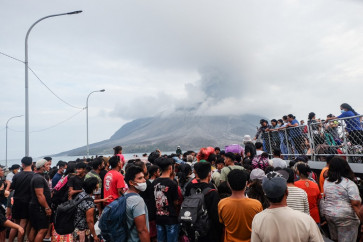App-based ‘ojek’ drivers clog Jakarta roads
Jakartans are now used to seeing groups of app-based ojek (motorcycle taxi) drivers occupying sidewalks and roadsides while waiting for passengers
Change Size

J
akartans are now used to seeing groups of app-based ojek (motorcycle taxi) drivers occupying sidewalks and roadsides while waiting for passengers.
As the number of the drivers has grown in recent years, the crowds have begun to cause traffic jams in some areas, especially near train stations where hundreds of commuters arrive in need of onward transportation.
The drivers, who hail from all over Greater Jakarta, can be seen clustered around train stations despite routine operations conducted by the police and Jakarta Transportation Agency.
In Palmerah Station in West Jakarta, hundreds of ojek drivers typically wait for their passengers on the side of the road, occupying almost one-third of the available street space during rush hours.
This has caused severe congestion in the area as passing traffic is forced to share the remaining lanes with Transjakarta feeder buses.
Ronny Firmansyah, 24, a driver who frequently picks up passengers at the station, said the spot was his favorite because of the availability of customers.
Palmerah is a popular stop for workers from South Tangerang and other areas in the western part of the capital traveling to business districts around Jl. Sudirman and other parts of South and West Jakarta.
“I can get passengers more easily in Palmerah Station and some malls nearby. Every day I can serve eight to 10 passengers,” the West Jakarta resident said.
Even though he was often reprimanded by transportation agency officers, Ronny said there was no other place to wait for passengers.
Another online ojek driver, Sugeng Santoso, 26, a resident of Ciledug, Banten, prefers Karet Station in Central Jakarta as he can pick up 12-15 passengers per day.
This is much higher than spots in Ciledug where he could only get three or four orders, he said.
Even though he knew waiting for passengers by the side of the crowded road hindered other road users, Sugeng said he would keep waiting for his passengers there.
“I hope the city administration can pay attention to us and provide the drivers with a special place to wait for passengers. If they fail to provide that, we will keep playing cat-and-mouse with law enforcers,” he said.
The city administration has prepared a vacant plot in Dukuh Atas, Setiabudi, Central Jakarta, to accommodate online and conventional ojek drivers waiting for passengers at Sudirman Station.
The deputy head of the Jakarta Transportation Agency, Sigit Wijatmoko, said the city administration would also provide similar space near Tanah Abang Station. “The space will accommodate 387 ojek drivers,” he said.
The city administration will also build parking spaces for the drivers at another 15 stations, including Tebet, Manggarai and Cawang.
Meanwhile, to ease the traffic congestion caused by the online ojek drivers, Jakarta Traffic Police chief Sr. Comr. Halim Pagarra said the police would continue cracking down on ojek drivers who violated regulations.
“We will give warnings to the violators, especially to drivers who wait for passengers on roads with traffic signal lights,” he said.
Halim added he had asked raid-hailing companies to keep reminding their drivers about the traffic regulations.
Transportation Studies (Instran) researcher Deddy Herlambang has estimated there are some 500,000 online ojek drivers in the city.
City residents have grown dependent on online ojek amid the inadequate public transit systems in the city.
He added that the administration should not focus on providing parking areas for online ojek drivers, but rather attempt to integrate public transportation.
“If public transportation facilities were well-developed, commuters would prefer to use public transportation instead of ojek,” Deddy said.









